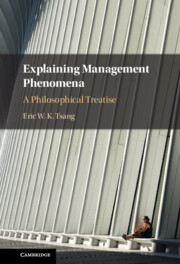Book contents
- Explaining Management Phenomena
- Explaining Management Phenomena
- Copyright page
- Contents
- Figures and Tables
- Preface
- Articles
- Chapter 1 The Nature of Explanation
- Chapter 2 Causation
- Chapter 3 Modes of Explanation
- Chapter 4 Microfoundations
- Chapter 5 Theory versus Non-theory–Based Explanation
- Chapter 6 Multi-theoretical Explanation
- Chapter 7 Research Methods
- Chapter 8 Explanation as Science (or Art?)
- Appendix Chinese Philosophy and Scientific Research
- Notes
- References
- Index
Chapter 8 - Explanation as Science (or Art?)
Published online by Cambridge University Press: 15 December 2022
- Explaining Management Phenomena
- Explaining Management Phenomena
- Copyright page
- Contents
- Figures and Tables
- Preface
- Articles
- Chapter 1 The Nature of Explanation
- Chapter 2 Causation
- Chapter 3 Modes of Explanation
- Chapter 4 Microfoundations
- Chapter 5 Theory versus Non-theory–Based Explanation
- Chapter 6 Multi-theoretical Explanation
- Chapter 7 Research Methods
- Chapter 8 Explanation as Science (or Art?)
- Appendix Chinese Philosophy and Scientific Research
- Notes
- References
- Index
Summary
The terms “inference to the best explanation” and “abduction” are often used interchangeably. Yet inference to the best explanation is concerned mostly with the choice of explanations by researchers based on their findings generated from data and is supposed to be in the last stage of an empirical study. In contrast, abduction is about formulating hypotheses and selecting the more promising ones to test before or after data collection, and thus corresponds to an earlier stage of inquiry. Given a set of data collected on a phenomenon, there are no systematic steps for reaching the best explanation for the phenomenon. That said, this concluding chapter suggests seven heuristics derived from Chapters 5 to 7, aimed at assisting management researchers to explain their findings. Constructing an explanation involves a great deal of judgement and decision making as well as requires imagination and intuition. The process arouses a variety of feelings and emotions. In short, explaining management phenomena is not just a scientific endeavor but also an art.
Keywords
- Type
- Chapter
- Information
- Explaining Management PhenomenaA Philosophical Treatise, pp. 203 - 212Publisher: Cambridge University PressPrint publication year: 2022

